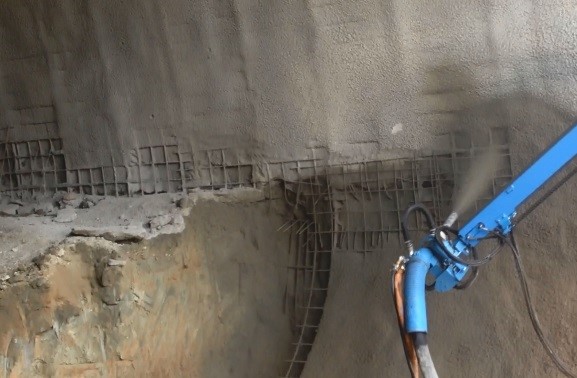HOTCRETE
Shotcrete is concrete that is sprayed onto a surface using high air pressure and is self-compacting. In order for shotcrete to be applied, it must achieve early setting and gain strength. For this purpose, set accelerators are used in shotcrete mixtures.
Shotcrete can be applied in two systems: dry mix and wet mix. In the dry mix system, a dry mixture of cement, aggregate, and powder set accelerators is loaded into a machine. With the help of compressed air, it is conveyed through hoses to the nozzle. Water necessary for hydration is added at the nozzle. In the wet mix system, cement and aggregate are loaded into the machine. Water and liquid set accelerators are added at the nozzle. In the wet system, a concrete mixture with a controlled water/cement ratio and chemical additives, similar to normal concrete applications, is prepared and pumped from the hose to the nozzle with the appropriate equipment. Compressed air and liquid set accelerators are added to the concrete at the nozzle for spraying.
Where is Shotcrete Used?
Shotcrete is used for rock and soil support in tunnels, mines, hydroelectric projects, and slope stabilization in both dry mix and wet mix applications.

Shotcrete Set Accelerators
Shotcrete accelerators can be classified into three groups: sodium silicates, aluminates, and non-alkali set accelerators. Shotcrete additives are used at a ratio of 3% to 10% of the cement weight, depending on the type of cement and the desired setting time and strength values. While set accelerators have positive effects, they can also cause a certain decrease in final strength (especially with sodium silicates and aluminates). Therefore, the dosage of set accelerators is very important and should be as low as possible.
The additives used in shotcrete are usually white or cream-colored and are available in powder or liquid form. Their density at 20°C is 1.1 kg/L.
Effect of Shotcrete Additives:
On Fresh Concrete: Fast setting, reduced rebound rate, the ability to adhere to vertical and horizontal surfaces in thick layers, increased cohesion.
On Hardened Concrete: A 20% to 25% decrease in final compressive strength, insufficient durability, reduced freeze-thaw resistance, high hydraulic shrinkage.